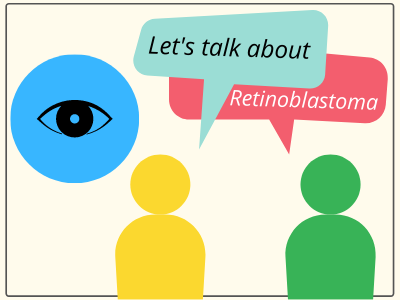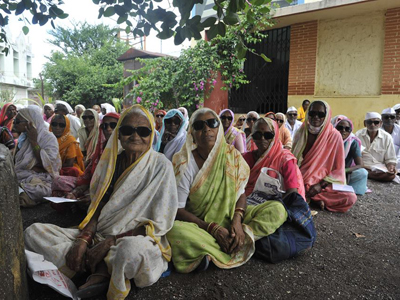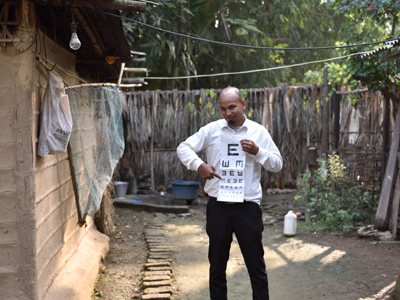Ounce of prevention - Worth a pound of cure
Created By: Debashis Maiti

Amidst the lockdown period for COVID-19 pandemic, I got the opportunity to train Mission for Vision’s community health workers from Kolkata. During deliberation, they candidly shared with me their customer experiences during their regular routine work. This conversation made me reminisce my own experiences in my previous employments with different multinational optical retail companies. This nostalgic sentiment made me revisit and search for those memorable photos and testimonials from patients I treated, either by way of eye prescriptions or mental support to uphold the zeal of visually impaired patients. The striking similarities in optical retail or in public eye health is endearing and with this post I wanted to share my experiences of delivering primary eye care, mainly through our Vision Centres.
The Five Senses
We have fundamentally five senses, the eyes to see, the tongue to taste, the nose to smell, the ears to hear, and the skin to touch. Out of these five senses, the eyes are one of the most used organs. We perceive up to 80% of all impressions by means of our sight. And if other senses such as taste or smell stop working, it's the eyes that best protect us from danger. Also when we learn, 75 percent of the knowledge comes to us visually, 13 percent comes through hearing and 12 percent comes through smell, taste, and touch.
Globally, it is estimated that at least 2.2 billion people have a vision impairment or blindness, of whom at least 1 billion have a vision impairment that could have been prevented or yet to be addressed. This 1 billion people includes those with moderate or severe distance vision impairment or blindness due to unaddressed refractive error (123.7 million), cataract (65.2 million), glaucoma (6.9 million), corneal opacities (4.2 million), diabetic retinopathy (3 million), and trachoma (2 million), as well as near vision impairment caused by unaddressed presbyopia (826 million).
In terms of regional differences, the prevalence of distance vision impairment in low and middle-income regions is estimated to be four times higher than in high-income regions. With regards to near vision, rates of unaddressed near vision impairment are estimated to be greater than 80% in western, eastern and central sub-Saharan Africa, while comparative rates in high-income regions of North America, Australia, Western Europe, and of Asia-Pacific are reported to be lower than 10%. Population growth and ageing will increase and add to the risk of vision impairment in people. To prevent this, we need to step up our efforts and address this with collaborative action.

Vision through Vision Centres
To address this massive challenge, we require effective and sustainable solutions. One such intervention is eye health delivery through Vision Centres (VC). These sustainable and easily accessible primary eye care clinics act as the first point of interface with the population by offering quality eye care services provided by a trained optometrist and health workers. These VCs provide comprehensive eye examination, detection of cataract and other ocular diseases, different surgery and medical treatment follow up at the base hospital for community patients, spectacle dispensing service and diabetic retinopathy screening. The VCs are mostly housed in community-based premises and staffing ranges from one to three staff members. Mission for Vision believes in providing high quality eye care services to the population, irrespective of their paying capacity. Mission for Vision’s adoption of the Vision Centre approach involves setting up a primary eye care clinic with high definition instruments for eye-screening and a well-stocked spectacle frame display of colorful frames of varied shapes/patterns/material at affordable price ranges to choose from.
Embracing the New Normal
The pandemic has limited movement for many of us and during the government-imposed lockdown, our Vision Centres were shut down temporarily from March to May 2020. Our staff and community health workers referred emergency cases to our partner eye hospitals during this period. Though many places started reopening from June onwards, there was a sense of fear looming around the minds of people. To banish those anxieties, MFV worked closely with the VC staff in providing them thorough training on the safety protocols. We effectively used the lockdown period to train the staff on new methods of screening, sanitisation of equipment, proper use of Personal Protective Equipment (PPE) and making some adjustments to the VC layout and seating arrangement. The training was done in accordance with the opinion from experts and as per the guidelines shared by the government and local authorities.

Once we set up these new processes and systems, our VCs resumed back to providing eye care services to these communities. The Vision Centre approach is of great significance during the COVID-19 pandemic, as it provides comprehensive eye care services closer to home for these communities, therefore minimising the need to travel to crowded cities. Here are some steps that our staff and eye health personnel follow in order to ensure safe delivery of services:
- Each patient to sanitise their hands before entering to the optical area.
- Patients are advised to wear masks properly and then enter the premises.
- The VC staff wear proper PPE kits that include the gown, head cap, mask and face shield
- Optometrists/Health workers maintain physical distance and talk less to the patient to minimise aerosols.
- All products are sanitised and are safe to try.
- The spectacle frames that have been tried on by patients undergo elaborate disinfection process post the trial process
- After every screening, the equipment are thoroughly cleaned and sanitized by the staff
- The equipment is covered with breath shields to avoid any contact
- Optometrists/health workers sanitise their hands before and after handling cash.
- Regular cleaning of the display table and other touch points are carried out at the VC.
During the entire process, physical distancing is maintained and spectacle dispensing also takes place following standard precautions as advised. Additional services are also offered to the patient like fundus photography, blood sugar/blood pressure test etc. at an affordable rate as required. A major portion of the cause leading to blindness and visual impairment can be identified, addressed and/or prevented at the primary level itself.
Collaborative Action
In partnership with leading eye health institutions and donor agencies, Mission for Vision has established 54 Vision Centres in 11 states of India and aims to set up 250 such centres over the next few years. Through this globally proven model, our plan is to reach the remotest parts of the country to enable eye health services to vulnerable communities, encourage people to seek care earlier, thus preventing vision problems from worsening and enabling people to reintegrate into the work force quickly.
About the Author
Debashis Maiti is a Senior Optometrist with MFV's Programme Development team. He has an overall experience of over 14 years, working as an Optometrist with leading eye care providers in the retail space.
SHARE NOW:
RELATED ARTICLES

Let's talk about Retinoblastoma: A conversation with two fathers
MFV staff Shrikant Ayyangar speaks to two fathers about retinoblastoma and their children's journey so far.
Read More
Measuring the impact of Cataract Surgery
Poverty is a cause and effect of visual and other disabilities that increases social divide. Eradicating avoidable blindness enhances productivity. It thus impacts the many millions who are stuck in the vicious cycle of poverty and poverty-induced disability.
Read More
The Quest to Finding Our Eye Health Hero
I was rummaging through some information on International Agency for the Prevention of Blindness’ (IAPB) website and I stumbled upon a poster for the Eye Health Hero nomination.
Read More